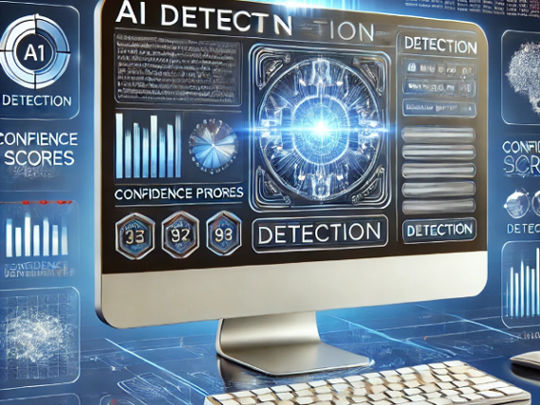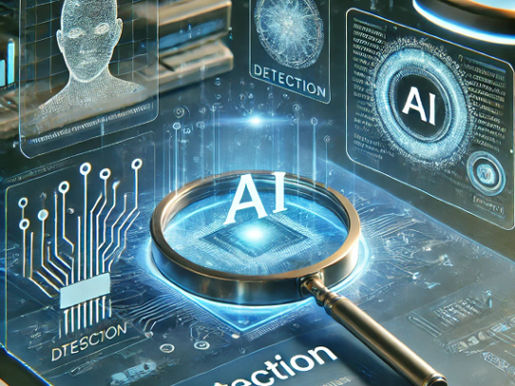Artificial Intelligence (AI) detection has become a pivotal aspect of modern technology. It helps identify AI-generated content, detect fraudulent activities, and safeguard systems from potential threats. This article delves into how AI detection works, how AI detection software operates, and explores strategies to make your work less detectable by AI. By the end, you’ll gain a clear understanding of the processes, tools, and practical applications of AI detection.
Understanding how AI detection works is essential in today’s AI-driven landscape. AI detection helps identify work made by AI and protects systems from dangers. Using the tools and strategies mentioned here, you can confidently move through the changing world of AI.
What is AI Detection?
AI detection is the process of determining if content, behavior, or patterns are artificial intelligence-influenced or generated. It has far-reaching applications in fields such as
- Educational: Identifying essays or assignments generated by AI tools.
- Business Environment: Identifying fraud or scams created by AI.
- Cybersecurity: Identifying malicious AI behaviors or bots.
Importance of AI Detection
AI detection ensures integrity, transparency, and safety in almost all fields. For instance,
- Academia: Ensuring originality in student submissions.
- Financial Services: Prevents fraudulent transactions.
- Social Media: Detects and eliminates fake accounts or automated activities.
AI detection is important to ensure that systems that are increasingly being influenced by artificial intelligence do not lose the trust of users.
How AI Detection Works

AI detection works through a series of advanced computational processes that identify AI-generated outputs. Here’s a breakdown of the process:
1. Data Collection
The first step is gathering massive datasets containing examples of both AI-generated and human-created content. These datasets help train algorithms to recognize differences.
2. Feature Extraction
Algorithms analyze the data to extract defining characteristics. For example:
- AI-generated text may exhibit repetitive patterns or overly formal structures.
- Images created by AI often lack natural imperfections seen in human-created visuals.
3. Pattern Recognition
After finding features, the system looks for patterns that are special to AI outputs. For example, AI text might:
- Use certain words too much.
- Do not make common mistakes that people make when writing.
4. Classification
In the end, classification models are used to find out if the content was made by AI. Common technologies include:
- Natural Language Processing (NLP): Looking at text patterns.
- Neural Networks: Recognizing complex behaviors in data.
- Deep Learning Algorithms: Getting better at accuracy by learning from data.
This step-by-step process helps in accurate detection with minimal false positives.
How Does AI Detection Software Work?

AI detection software helps in the analysis process, thus providing efficient and reliable identification of AI-generated content. Let’s see how it works:
1. Input Analysis
Users feed the input to the software, such as:
- Text: Essays, articles, or reports.
- Images: Graphics or photos.
- System Logs: Activity records for cybersecurity purposes.
2. Algorithm Application
The software applies pre-trained algorithms to analyze the input. For instance:
- NLP is used in text analysis tools to recognize unnatural phrasing.
- Image tools use inconsistency in texture or lighting to detect AI work.
3. Confidence Scoring
Confidence scoring represents the likelihood of AI generation. For example:
90% confidence score indicates that the software is very sure the content is AI-generated.
4. Detailed Reporting
The software creates a detailed report that contains:
- Highlighted patterns.
- Confidence levels.
- Recommendations for next steps.
How to Detect AI Work
Finding AI-generated work usually needs tools and careful attention to detail. Here’s how you can find it step by step:
1. Examine the Content
AI-created content often seems too organized or perfect. Watch for signs like:
- Repeated sentence patterns.
- No personal touch or special voice.
2. Leverage Detection Tools
Many AI detection tools can help with this:
- GPTZero: Focused on finding AI-written text.
- Deepfake Detection Tools: This can help identify AI-generated videos or images.
3. Check Metadata
Metadata in media files can provide some clues. The presence of missing or inconsistent metadata fields can indicate AI generation.
4. Collaborate with Experts
For complicated cases, seeking the expertise of data scientists or cybersecurity experts can help narrow down AI work.
How to Make Your Work Not AI-Detectable
Creating content that doesn’t trigger AI detection requires strategies to make your work seem more authentically human. Here’s how:
1. Add Personal Elements
Introduce anecdotes, personal insights, or subjective opinions. For example:
“I remember the first time I encountered AI detection software. Its accuracy amazed me, but it also raised questions about creativity.”
2. Vary Sentence Structures
Use a mix of short, long, and complex sentences. This mimics natural human writing patterns and reduces the predictability AI detection tools look for.
3. Introduce Minor Errors
Humans make occasional mistakes. Adding small grammatical errors or inconsistencies can make your work appear more organic.
4. Avoid Overuse of AI Tools
While AI tools can assist in content creation, over-reliance often results in detectable patterns. Review and revise AI-generated content manually.
By applying these tactics, you can make your work appear genuinely human and reduce the likelihood of detection.
Real-World Applications of AI Detection
1. Education
In schools and universities, AI detection helps keep academic honesty by finding essays written by AI tools like ChatGPT.
2. Business
Fraud detection systems in banks use AI detection to spot suspicious transactions and stop scams.
3. Social Media
Platforms like Twitter and Facebook remove bots and fake accounts through AI detection to make sure that interactions among users are genuine.
Ethical Considerations in AI Detection
With the emergence of AI detection, questions arise about the ethics involved:
- Privacy: What is the acceptable limit for the analysis of user data?
- Bias: Detection systems may show bias based on the training data.
It is essential to strike a balance between the use of AI detection and the ethical boundary.

1 thought on “How AI Detection Works”